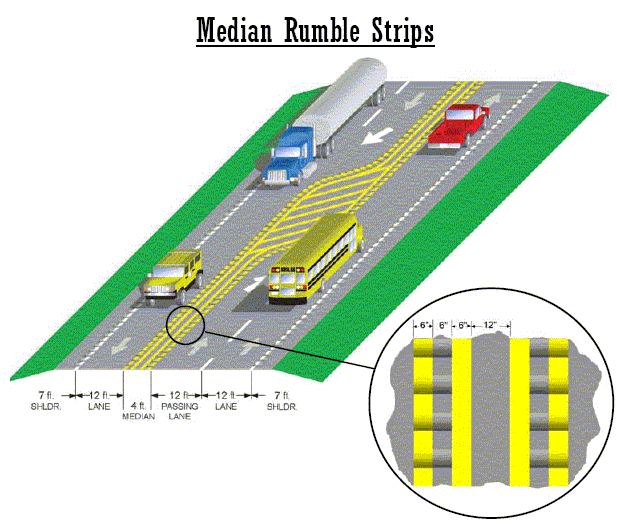Rumble strips are those textured patterns you often see on the edges of roads or in the center lines. They serve an important purpose in enhancing road safety. When a vehicle's tires run over these strips, they create a distinct sound and vibration, alerting drivers if they're veering off course. This blog post will guide you through the installation process, helping you understand not just how they're put in place, but why they are an essential feature on our roads today.
Purpose and Benefits of Rumble Strips

Rumble strips have gained popularity in road safety measures due to their effectiveness in reducing accidents. Let’s dive into their purposes and the numerous benefits they offer.
1. Enhancing Driver Awareness:
The primary purpose of rumble strips is to alert drivers when they are straying from their lane or approaching hazardous areas. The tactile feedback and accompanying noise serve as an immediate wake-up call, especially for distracted or drowsy drivers.
2. Preventing Lane Departure Accidents:
According to safety studies, lane departure accidents can lead to serious injuries. Rumble strips help mitigate this risk. By providing a physical warning before drivers potentially lose control, they can save lives. States like California have reported a significant drop in crashes on highways where rumble strips are installed.
3. Cost-Effective Safety Solution:
In terms of cost-effectiveness, installing rumble strips is relatively inexpensive compared to other road safety measures. When you consider the potential costs associated with accidents—including medical expenses, property damage, and legal fees—the investment in rumble strips pays off quickly.
4. Versatility in Application:
Rumble strips can be tailored to fit various road conditions. They can be placed on highways, at intersections, and even in school zones, adapting to the unique needs of each area. For instance, centerline rumble strips can help prevent head-on collisions by alerting drivers when they drift into oncoming traffic.
5. Supporting Pedestrian Safety:
In urban areas, rumble strips can also enhance pedestrian safety. When placed at crosswalks, they alert drivers to slow down, helping to protect vulnerable road users. A community initiative in New York City demonstrated that adding rumble strips near schools led to a notable decrease in speeding incidents during school hours.
6. Minimal Disruption During Installation:
The installation process for rumble strips is quick and minimally disruptive to traffic. Using specialized machinery, crews can cut into the road surface in a matter of hours. This efficiency means that roads can remain operational during the installation, further enhancing the appeal of rumble strips as a safety feature.
In conclusion, the purpose and benefits of rumble strips extend beyond mere noise and vibration. They are a crucial component in the broader strategy of improving road safety, making them indispensable in today’s transportation landscape. Whether you’re a driver or a community planner, understanding their significance can help foster safer roads for everyone.
Also Read This: Where Was the Royal Rumble Held?
3. Materials Used in Rumble Strip Installation

When it comes to installing rumble strips, choosing the right materials is essential for ensuring durability and effectiveness. Here's a breakdown of the key materials typically used in the installation process:
- Asphalt: This is one of the most common materials for rumble strips, especially on highways. It's durable and can withstand heavy traffic while providing a good surface for creating the rumble effect.
- Concrete: In areas where asphalt wear is a concern, concrete is often used. It offers greater longevity but can be more expensive and labor-intensive to install.
- Epoxy Resin: For painted rumble strips, epoxy resin is used. It helps the strip adhere to the road surface and provides a vibrant color that enhances visibility.
- Reflective Beads: These are often added to the paint or material used for rumble strips. They enhance visibility at night and during inclement weather, ensuring drivers can see the warning signals from a distance.
- Traffic Safety Tape: Some installations utilize specialized traffic safety tape as a temporary solution. It’s easy to apply and remove but might not provide the same durability as other materials.
Each of these materials serves a distinct purpose in the installation process, contributing to the overall effectiveness of the rumble strips in alerting drivers. Ensuring you choose the right combination for your specific environment is crucial. For instance, areas with heavy rainfall may benefit more from epoxy and reflective beads to ensure maximum visibility and safety.
Also Read This: How to Watch Rumble on Roku: A Step-by-Step Guide
4. Step-by-Step Installation Process
Installing rumble strips involves several steps, each critical to ensuring they are effective and long-lasting. Here’s a simple, step-by-step guide to the installation process:
- Planning and Design: Before any installation begins, it's essential to assess the area. Determine the length and type of rumble strips needed based on traffic patterns and road conditions. Consult local regulations to ensure compliance.
- Surface Preparation: The installation area must be cleaned and prepared. Remove any debris, loose gravel, or old road markings. This ensures that the new materials adhere properly.
- Marking the Layout: Use chalk or paint to outline where the rumble strips will be placed. This serves as a guide during installation to ensure they are evenly spaced and properly aligned.
- Installing the Rumble Strips: Depending on the chosen material, this step will vary. For asphalt or concrete strips, use a milling machine to cut grooves into the surface. If using painted strips, apply the paint mixture evenly along the marked lines, incorporating reflective beads if needed.
- Quality Control: After the installation, conduct a thorough inspection. Ensure the strips are consistent in depth and width and properly aligned. Address any discrepancies immediately to avoid safety issues later.
- Final Touches: If using temporary materials like tape, make sure to follow up with permanent solutions as soon as possible. Clear away any excess materials or markings from the installation process.
By following these steps carefully, you can ensure that the rumble strips are installed correctly, enhancing road safety for everyone. Remember, proper installation not only helps in alerting drivers but also contributes to longer-lasting road infrastructure.
Also Read This: How to Beat Rumble in Blox Fruits and Master the Game’s Challenges
5. Safety Measures During Installation
When it comes to installing rumble strips, safety should always be your top priority. Whether you're a professional or a DIY enthusiast, adhering to safety measures can prevent accidents and ensure a smooth installation process.
Here are some essential safety measures to keep in mind:
- Personal Protective Equipment (PPE): Always wear appropriate PPE. This includes hard hats, safety goggles, gloves, and reflective vests to ensure visibility, especially when working near traffic.
- Site Assessment: Before starting, conduct a thorough assessment of the installation site. Look for any potential hazards such as uneven terrain, overhead power lines, or nearby traffic.
- Traffic Management: Implement a comprehensive traffic management plan. Use cones, barriers, and signage to redirect traffic and ensure that drivers are aware of the work area.
- Clear Communication: Establish clear communication among team members. Use hand signals, radios, or other methods to ensure everyone is aware of movements and tasks.
- Weather Conditions: Monitor weather conditions. Avoid installation during inclement weather, as rain, snow, or strong winds can create hazardous conditions.
By taking these precautions, you not only protect yourself and your team but also ensure that the installation process is efficient and effective. Remember, a little preparation goes a long way in maintaining a safe working environment.
Also Read This: Who Won the 2015 Royal Rumble? Revisiting an Action-Packed Match
6. Common Challenges and Solutions
Every installation project comes with its own set of challenges, and rumble strip installations are no exception. Being prepared for these common issues can help you navigate them more smoothly.
Here are some challenges you might face and practical solutions:
| Challenge | Solution |
|---|---|
| Inconsistent Material Quality | Always source materials from reputable suppliers. Conduct pre-installation tests to ensure that the quality meets the required standards. |
| Incorrect Alignment | Use marking tools and measuring devices to ensure that strips are installed in the correct position. Regularly check alignment during installation. |
| Environmental Conditions | Plan installations for optimal weather conditions. If it rains, wait for the surface to dry completely before continuing. |
| Equipment Malfunctions | Perform regular maintenance and checks on all equipment before starting the project. Have a backup plan or alternative equipment available. |
By addressing these challenges proactively, you can minimize setbacks and ensure a successful rumble strip installation. The key is to stay organized, communicate effectively, and be ready to adapt to any unexpected issues. Happy installing!
Also Read This: Are You Ready to Rumble Trademark: The Legal Journey of This Iconic Phrase
7. Maintenance and Longevity of Rumble Strips
When it comes to ensuring the effectiveness and longevity of rumble strips, regular maintenance is key. These road safety features, while robust, do require some attention to keep them functional and effective. Here are a few important aspects to consider:
- Regular Inspections: Depending on the traffic volume and weather conditions, it's crucial to conduct regular inspections. Look for signs of wear, such as indentations, cracks, or fading colors.
- Cleaning: Accumulations of dirt, debris, or snow can obscure the visibility and effectiveness of rumble strips. Regular cleaning, especially during harsh weather, can help maintain their integrity.
- Repairing Damage: If you notice damage during inspections, address it immediately. Filling in gaps or reapplying markings can enhance visibility and keep the strips' functionality intact.
- Material Considerations: Opt for high-quality materials that are resistant to wear and tear. For example, polymer-based rumble strips tend to perform better in extreme weather conditions than traditional asphalt.
In terms of longevity, the lifespan of rumble strips can vary based on several factors, including:
- Traffic Volume: Higher traffic volumes can lead to quicker wear. Rumble strips on highways may need more frequent attention than those on rural roads.
- Environmental Factors: Exposure to ice, snow, or heavy rains can expedite wear. Locations with extreme climates should consider materials that withstand such conditions.
- Design and Installation Quality: Proper installation is critical. Poorly installed rumble strips may suffer from structural issues sooner, making initial quality a crucial investment.
By focusing on these maintenance tips and understanding the factors influencing longevity, you can ensure that your rumble strips serve their purpose effectively for years to come. Remember, the goal is to maintain safety on the roads, and a little upkeep goes a long way!
8. Conclusion and Final Thoughts
In conclusion, the installation of rumble strips is a critical step in enhancing roadway safety. As we’ve explored throughout this guide, the process involves careful planning, precise execution, and ongoing maintenance. Here are the key takeaways:
- Safety Enhancement: Rumble strips significantly decrease the risk of run-off-road accidents, providing a simple yet effective alert system for drivers.
- Installation Matters: The success of rumble strips relies on proper installation techniques, including correct placement and material selection.
- Ongoing Maintenance: Regular inspections and maintenance are essential to prolong their lifespan and effectiveness.
As we move forward in our road safety initiatives, implementing rumble strips should be viewed as an investment in our communities' safety. They serve as a tangible reminder to drivers to stay alert and maintain focus while navigating the roads. If you’re considering integrating rumble strips into your local traffic management strategy, remember that the benefits far outweigh the challenges. Ultimately, a well-maintained rumble strip can help save lives, making our roads safer for everyone.
So, whether you're a transportation planner, a safety advocate, or just a concerned citizen, advocating for rumble strips is a step in the right direction. Let’s work together to ensure our roads are as safe as they can be!
 admin
admin








